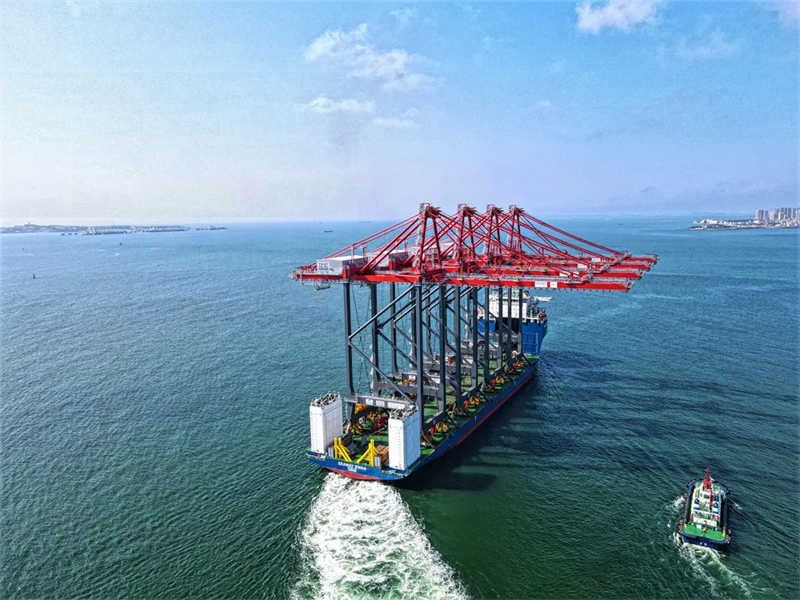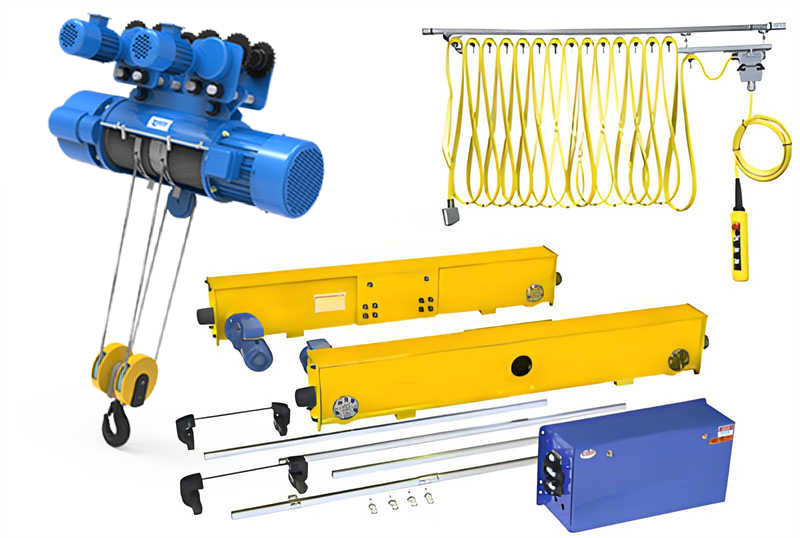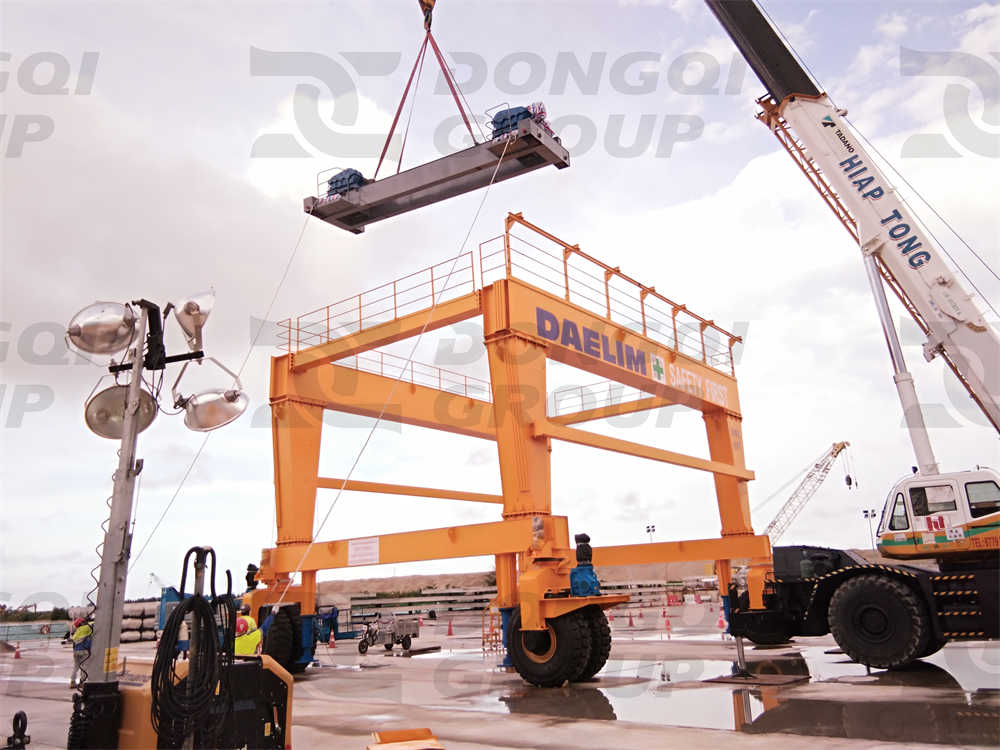14-Jan-2025
Design of 40.5t rail mounted container gantry crane
Introduction
Under the background of global economic integration, international economic and trade activities are becoming more frequent. As a bridge connecting ocean transportation and land economy, the transportation efficiency and throughput capacity of ports directly affect the smoothness of the entire supply chain, and thus are related to the healthy development of the economies of various countries and even the global economy. Especially in the global trade pattern, the efficiency of cargo loading and unloading transportation in ports is particularly important. Rail-mounted container gantry cranes (RMGs) have become one of the indispensable key loading and unloading equipment in modern ports due to their high efficiency and reliability, and play a decisive role in improving the overall operating efficiency and economic benefits of ports.
In order to adapt to the growing cargo throughput and diversified loading and unloading needs, this design aims to deeply explore the potential for improving the loading and unloading efficiency of port machinery, and carefully design and build a 40.5t rail-mounted container gantry crane with high load capacity, large span operation capacity and strong lifting height. This crane will adopt advanced structural design concepts and optimization solutions to ensure that the loading and unloading operation speed and automation level are maximized under the premise of ensuring safety, thereby effectively alleviating the operating pressure of busy ports, reducing logistics costs, and promoting the sustainable and healthy development of global trade.
Design Overview
Functions and Applications
Rail-mounted container gantry cranes are mainly used for loading and unloading and stacking operations in container cargo yards. This crane can lift one container over three containers within the travel distance of the gantry crane. It has an outreach of 13 meters on both sides, plus a working length of 60 meters within the span of the gantry, forming an 86-meter-long trolley operation line. The crane can stack 21 rows of containers within the span of the gantry and load and unload containers in the lane at the outreach.
Main Technical Parameters
- Lifting capacity: 40.5t
- Track gauge: 35 meters (or adjusted according to specific needs)
- Span: 60 meters (working length)
- Outreach: 13 meters
- Lifting height: designed according to specific needs
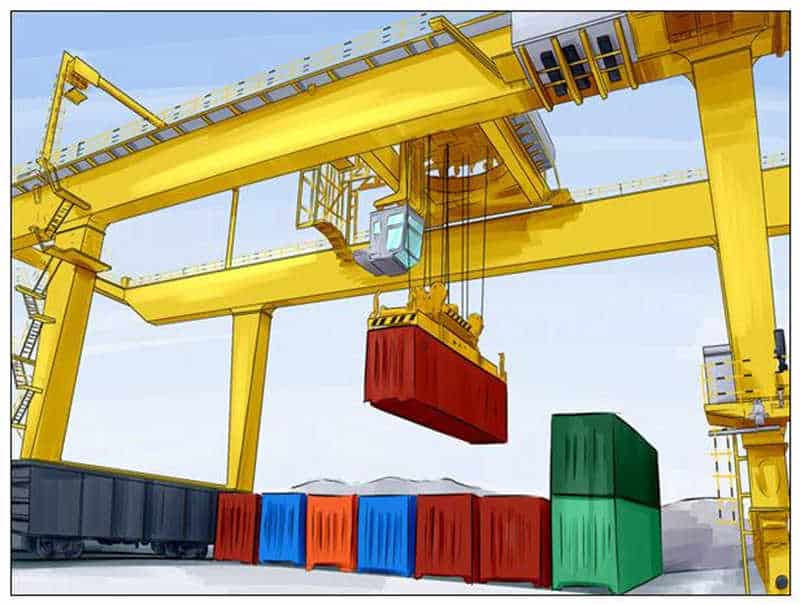
Structural design
Main structure
The main structure of this crane adopts high-strength steel plates and advanced welding technology to build a stable and efficient box-shaped welded structure. The core part of the structure is the top horizontal frame composed of two off-track box-shaped main beams and two parallel box-shaped cross beams. Through precise calculation and high-quality welding materials, they ensure that the entire frame can provide sufficient strength and rigidity when bearing vertical loads. The two off-track box-shaped main beams extend along the track direction and support most of the weight of the crane, while the cross beams ensure the stability of the gantry and sufficient static load capacity.
Two U-shaped vertical frames are designed at both ends of the main beam. They are composed of two vertical legs and a horizontal lower cross beam. The legs are connected to the main beam by flanges and bolts. This connection method not only ensures the firmness of the structure, but also facilitates installation and maintenance. The lower cross beam forms a right angle with the legs, further enhancing the stability of the entire structure. In addition, all connection parts use high-strength bolts and flanges to ensure that there will be no loosening or deformation problems in a high-intensity working environment.
Hoisting device design
This crane is equipped with a full-rotation telescopic hoisting device, which has the functions of opening, closing, locking and telescopic, and these operations can be completed remotely in the driver’s cab. According to actual operation requirements, the hoisting device can be flexibly configured to a standard length of 20 feet or 40 feet, and it also has the option of a double-box hoisting device, making the crane more widely applicable and efficient.
Operating mechanism
The operating mechanism of the crane covers key components such as the lifting mechanism, trolley operating mechanism, trolley mechanism and anti-sway mechanism. Among them, the lifting mechanism, trolley operating mechanism and trolley operating mechanism mostly adopt advanced AC frequency conversion control technology to achieve precise and efficient motion control. The lifting mechanism is usually designed as a single drum form, and can also be specially customized as a double-drum open structure according to special needs to adapt to different lifting operation scenarios.
Driver’s cab design
The driver’s cab adopts a suspension support design and has the characteristics of self-closure. It is installed on the driving track under the main beam to ensure that the driver has a stable field of vision and a good working environment during operation. The driver’s cab is equipped with a complete operating console for controlling various mechanisms of the crane, making operation easier.
Installation and commissioning
Installation plan
The installation process of the rail-mounted double-girder container gantry crane is relatively complex and requires precise planning and execution. Due to the large size and complex structure of this type of crane, it is necessary to select appropriate lifting equipment and methods. A common installation plan is to use tools such as pulley blocks, winches and wire ropes to first lift and fix the door legs (i.e., U-shaped door frames) vertically to ensure the verticality and accurate position of the door legs. Next, use a mast crane to lift the main beam horizontal frame above the door legs and accurately connect it to the door legs to form a stable gantry structure. Finally, use the same lifting equipment to lift the trolley components into place and install them accurately.
At the construction site, the impact of road and operating conditions on the lifting equipment must be considered. For the installation of large cranes, truck cranes are preferred as the main lifting equipment. Its advantages are strong mobility, ability to adapt to complex construction site environments, and sufficient lifting weight and operating height. At the same time, in order to ensure the safe and efficient completion of the installation task, the construction site should ensure good road traffic capacity so that the crane can enter and exit the site smoothly; the working space should be large enough to meet the safe working radius and height required during the hoisting process; and the impact of factors such as obstacles and underground pipelines on the hoisting operation should be fully considered to ensure the smooth progress of the entire installation process.
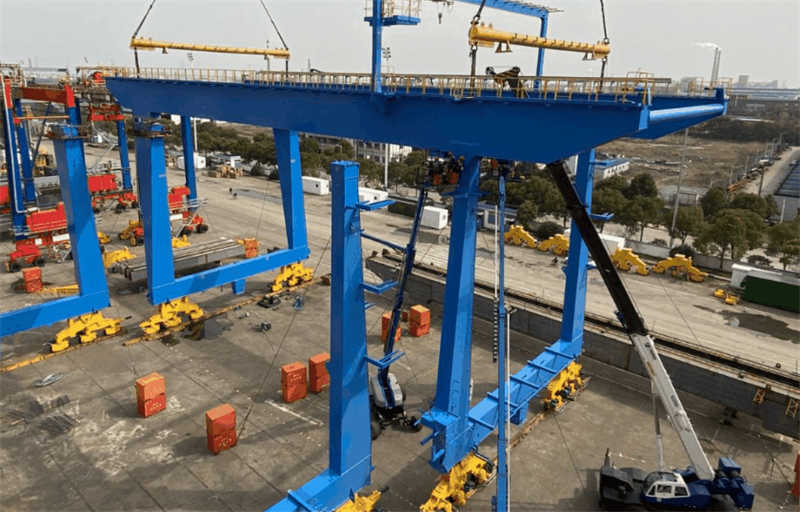
Debugging and inspection
After the installation of the crane is completed, comprehensive debugging and inspection work must be carried out. The debugging content includes but is not limited to mechanical structure debugging, electrical system debugging, and safety protection device verification. Through the no-load test, the operating stability of the crane, the flexibility and coordination of the movements of each mechanism are verified; through the full-load test, the load-bearing capacity, braking performance, and the strength and reliability of each component of the crane are tested. In addition, the safety of the crane needs to be evaluated to ensure that it meets the relevant national standards and specifications and effectively eliminates potential safety hazards.
Technical features and innovations
Large tonnage, large span, high lifting capacity design
The crane has a designed lifting capacity of 40.5 tons. Its large tonnage design allows it to easily cope with the lifting needs of various weight classes of cargo in various heavy lifting operations. The large span means that the crane has a wider operating range. Whether it is a warehouse with a large space, a dock or a complex and changeable construction site, it can be easily covered, significantly improving the operating capacity and flexibility. The high lifting height is a highlight of this crane, which can meet the needs of lifting ultra-high cargo and reduce the loss of cargo during transportation and storage, thus ensuring the safety and efficiency of operations.
Environmentally friendly and energy-saving drive system
This crane adopts mains power drive mode, which eliminates the noise and harmful emissions produced by traditional internal combustion engines and achieves green and environmentally friendly operations. The mains drive system provides stable and efficient kinetic energy for the crane. It is especially suitable for fixed places that require long-term continuous operation, such as docks, warehouses, etc. It effectively reduces carbon emissions while ensuring operational needs, and actively responds to sustainable development. and the call for green logistics.
Intelligent management and precise operation system
The crane can be equipped with an advanced whole-ship container positioning scanning system and CNC system, which can automatically find the coordinates of the container through computer operation and perform precise docking and lifting. This intelligent management system greatly improves work efficiency and quality, reduces manual operation errors, and achieves precise operations. It not only reduces the labor intensity of workers, but also greatly improves the automation and service level of the entire operating process.
Conclusion
In this design, we adhere to the core principle of improving the efficiency of port machinery loading and unloading, and carefully design a 40.5-ton rail-mounted container gantry crane with large tonnage carrying capacity, large span operating range and ultra-large lifting height. This crane is designed to meet the efficient, safe and environmentally friendly operation needs of modern ports. Through the deep integration of modern design concepts and technical means, including the use of advanced parametric modeling methods and three-dimensional simulation design software, and the use of mature finite element analysis theory to conduct detailed mechanical performance analysis and optimization of the whole machine structure, it ensures that the designed crane has excellent structural rationality, safety and reliability while maintaining high strength and durability.
The successful design of this 40.5-ton rail-mounted container gantry crane will undoubtedly play a key role in improving the efficiency of port cargo loading and unloading. Its large tonnage design capacity can cope with the challenges of loading and unloading various heavy goods, and the large span operating range enables the crane to flexibly perform various complex operations in a wide space. In addition, the ultra-large lifting height further enhances the crane’s adaptability to different cargoes and scenarios, enabling it to efficiently complete various loading and unloading tasks, whether in deep-water docks or multi-storey warehouses.
Against the backdrop of global economic integration and the rapid development of international trade, the design of this new crane not only conforms to the trend of the times, but is also an important step in promoting the modernization of port logistics. Its implementation will save labor costs for ports, increase cargo turnover speed, and enhance logistics efficiency, thereby effectively promoting the intelligent and automated process of ports, further optimizing global supply chain management, and injecting new vitality into promoting economic globalization and the development of international trade.

